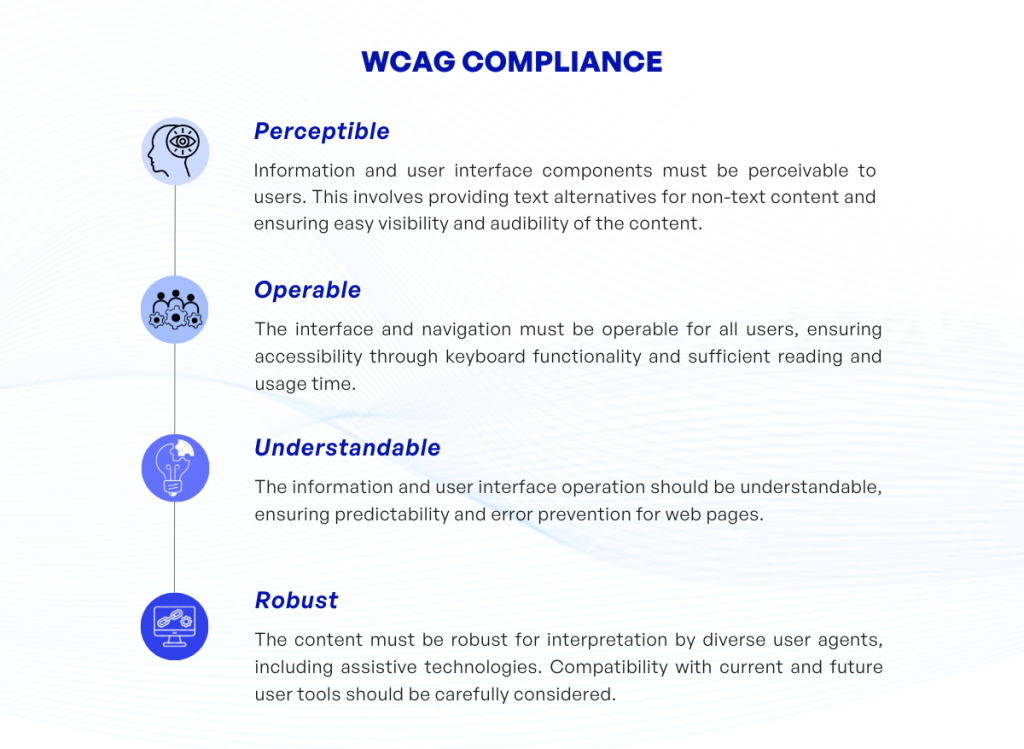
Did you know that over a billion people globally, approximately 15% of the world’s population, experience some form of disability? Such a vast demographic can’t simply be ignored when developing a product. Let’s dive into how focusing on product accessibility is not just a considerate, inclusive choice but, indeed, a smart business move.
Designing products accessible to everyone, regardless of their abilities, ensures we can connect and engage people universally.
- Universal Design: This concept guides accessible product development, aiming to make every product usable by all people, to the greatest extent possible, without the need for adaptation or specialized design.
- Inclusive Design: This perspective emphasizes the contribution of diverse user experiences and needs to help shape a product that is genuinely accessible to all.
As product developers, it’s our inherent responsibility to understand and apply these principles to empower all users and create truly accessible products.
1. Introduction
Welcome, dear reader. Ever wondered why ‘accessibility’ has become a buzzword in the realm of product development? Or perhaps, you’re curious about how this concept can shape the success trajectory of a product. Bucks-up then, you’re in the right place! In this article, we will dive into the concept of accessibility, discuss its importance, and, more importantly, highlight the need and methods to incorporate it into product development.
Let’s start with the basics. What exactly does ‘accessibility’ mean in a product development context? In essence, accessibility is about making products usable for as many people as possible, irrespective of any disability or impediment they may have. It ensures that everyone has an equal opportunity to use and enjoy a product—be they visually impaired and using a screen reader, or physically disabled and navigating a website with a specialized keyboard.
So, ready to begin this enlightening journey into the world of accessibility? Read on, dear reader, and let’s delve into the importance and implementation of accessibility in product development.
2. The Importance of Accessibility
Before we delve into the practicalities of incorporating accessibility into product design, let’s take a moment to address why accessibility matters so much. Do you ever consider how many people are left out if a product isn’t accessible? The numbers might surprise you.
An informative survey by the World Bank states that 15% of the world’s population experience some form of disability (World Bank, 2021). That translates to over a billion people who could be facing barriers in accessing products that are not designed with accessibility in mind. So, is it not fair to say, then, that accessibility, in fact, is an essential factor? It certainly is!
You might be thinking, isn’t accessibility just about compliance with regulations? Sure, compliance is a significant part of it, but it’s not the whole picture. While adhering to legal standards is imperative, it doesn’t necessarily mean that a product is universally accessible or user-friendly.
Accessibility is about inclusivity and equality. It’s about making sure the broadest range of people, irrespective of their age, ability, or circumstance, can use and benefit from a product. That includes those with disabilities – like visual impairment, hearing loss, physical disabilities, and cognitive limitations- but accessibility also benefits others. Ever tried to watch a video without audio while in a loud place? You’ve experienced how beneficial captions can be. They’re a feature implemented for accessibility, but surely, they help a lot more people.
Moreover, embracing accessibility improves a company’s reputation, demonstrating a commitment to fair and inclusive practices, and more user-friendly products. It also broadens the potential customer base, reaching out to that 15% otherwise neglected. Clearly, the importance of accessibility extends well beyond just meeting regulatory requirements.
3. Inclusive design
Imagine this: You’ve spent countless hours perfecting a product that your team believes is revolutionary. Sure, it looks slick, it’s user-friendly, and it’s loaded with neat features. But what if you suddenly realize half the global population is left out because the product isn’t accessible to everyone? This is where the concept of Inclusive Design comes into play.
Inclusive design is not just a buzzword, it’s an essential factor in product development. It’s an approach that puts human diversity at the heart of the design process. Its goal? To create products that are accessible to, and usable by, as broad a range of users as possible. Sounds like something we should aim for, right?

But how do you incorporate this approach into your product development? How can you ensure that your design is, in fact, inclusive?
- Understand your user base: Knowing who your users are is key. Remember, we’re talking about a global, diverse user base. This includes understanding their needs, abilities, and limitations. Your users may range from those with visual impairments, physical disabilities, cognitive issues, and the elderly, to those with temporary limitations, like a broken arm. Wondering how to capture all these varied needs? The key is conducting thorough and inclusive user research.
- Design for flexibility: Every person is unique and will interact with your product in different ways. Therefore, one size doesn’t fit all. The design should be flexible enough to cater to different user needs. This could mean providing different ways to navigate, adjustable font sizes, or options for high contrast mode.
- Consistent design: A consistent design language helps all users quickly understand how to use your product. It also makes it easier for assistive technologies to navigate your product.
- Consider cultural differences: When you’re designing for the world, cultural differences can’t be overlooked. Images, color schemes, and even certain phrases can have different meanings in different cultures. Neglecting this could lead to confusion or offense.
“The power of the Web is in its universality. Accessibility by everyone regardless of disability is an essential aspect,” once noted the Web’s creator, Tim Berners-Lee. A perspective that still holds true today and is the foundation of inclusive design.
Embracing inclusive design not only makes your products usable by more people but also often results in better products for everyone. Because, in the end, who doesn’t like a product that is easy to use, isn’t that correct?
4. WCAG compliance
Now you might be wondering, ‘What is WCAG compliance and how does it relate to accessibility in product development?’ Well, the Web Content Accessibility Guidelines, often abbreviated as WCAG, act as the principal driving force behind creating accessible digital products. This set of guidelines has been drawn up by experts around the globe to ensure that digital content is accessible to all users, regardless of their abilities.

Meeting WCAG compliance is not merely an act of ticking off criteria on a checklist. Rather, it induces the very spirit of accessibility into your product right from the development stage, ensuring that it caters to a broad range of users. So, how does one comply with these guidelines?
- Perceptible: This means that the information being presented and the user interface components must be presentable to users in ways they can perceive. This includes considerations like providing text alternatives for non-text content or making it easier for users to see and hear content.
- Operable: The interface and navigation must be operable, which means that all users must be able to operate the interface. This could involve making all functionality available from a keyboard or giving users enough time to read and use the content.
- Understandable: The information and the operation of the user interface must be understandable. In practice, this could mean that web pages appear and operate in predictable ways or that users are helped to avoid and correct mistakes.
- Robust: The content must be robust enough to be interpreted by a wide variety of user agents, including assistive technologies. Essentially, this means the compatibility of current and future user tools should be thoroughly considered.
While these might seem like broad categories, the WCAG offers specific guidelines and success criteria for each one. This robust system was designed to keep user accessibility front and center, ensuring that everyone has a fair shot at leveraging digital tools to their full potential.
Adhering to the WCAG guidelines is not just a matter of compliance but of ethical product development. Can you imagine a world where your product can be used by anyone, regardless of their abilities or disabilities? WCAG conformance turns this from an imaginative exercise into an achievable reality. It’s time to embrace accessibility and WCAG compliance in all our developmental efforts.
5. Accessibility Testing Tools
Now that you understand the crucial role of accessibility in product development and how to achieve WCAG compliance, you might be wondering, “What tools are available to assist in the process?” It’s a salient question, and fortunately, there are several accessibility testing tools that can help identify and mitigate accessibility issues in a product. These tools play a crucial role in your digital accessibility strategy. Let’s delve into some of the top choices.
5.1. Automated Accessibility Testing Tools
Automated testing tools provide a great starting point as they can scan your product for common accessibility issues. However, remember these tools can’t identify all issues and human involvement is needed to ensure complete accuracy.
- WAVE: Developed by WebAIM, this tool provides visual feedback about the accessibility of your web content by injecting icons and indicators into your page.
- AXE: A comprehensive, open-source tool that evaluates website code against WCAG and Section 508 compliance guidelines. It’s offered as a browser extension and API.
- SiteImprove: This tool offers insights into your website’s overall health, including accessibility, quality assurance, SEO, digital analytics, and more.
5.2. Manual Accessibility Testing Tools
Manual tools come into play for the issues that automated tools can’t detect.
- JAWS: This is the most popular screen reader worldwide, supporting web navigation and reading through text-to-speech.
- NVDA: A free and open-source screen reader that also allows humans to experience how a blind user interacts with their product.
- Color Oracle: A color blindness simulator that reveals to you what your product looks like to those with various forms of color blindness.
While choosing testing tools, remember to target tools that best meet your product’s specific needs. Combine automated testing, manual reviews, and user testing to ensure breadth and depth in your accessibility efforts.
So, now you’re equipped with an understanding of some high-quality accessibility testing tools. But how do you tackle potential accessibility problems that these tools may uncover? Let’s transition to our conclusion section to summarize the key points we’ve discussed throughout this article.
6. Conclusion
In conclusion, integrating accessibility into product development is not merely a good practice, but a critical factor that ensures far-reaching engagement and improved user experience. This process, from understanding the significance of accessibility to implementing and testing, might appear daunting, mightn’t it? But, remember it’s a journey. And every single step you take towards more accessible product development makes a real difference in people’s lives.
WCAG compliance, or meeting the criteria set out in the Web Content Accessibility Guidelines, is a robust starting point, a strong backbone that aids in formulating design strategies and development implementations. But is that all? No. Remember, we’re not restricting ourselves to checkboxes on a compliance list. Our ultimate goal is to create products that are genuinely accessible and provide equal user experiences for everyone, regardless of any impairments they may have.
We’ve explored various automated and manual accessibility testing tools. Each has its advantages and plays a vital role in identifying and resolving accessibility issues. It’s crucial to incorporate these tools into your product development process to identify potential barriers and correct them early in the development cycle.
At the end of the day, accessibility in product development is about empathy and inclusivity. It’s about understanding the varied needs of your user base and breaking down barriers that might prevent anyone from fully engaging with and enjoying your product. True accessibility in product development means considering these factors from day one. And the good news? Incorporating accessibility into your products doesn’t only make them better for people with impairments – it makes them better for everyone.
If you have any questions regarding accessibility in product development, feel free to contact KVY TECH.


